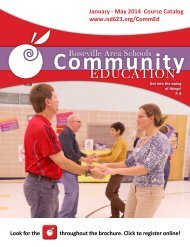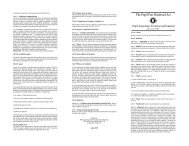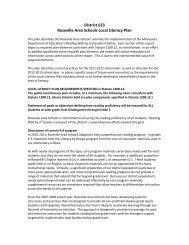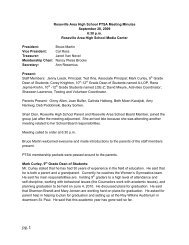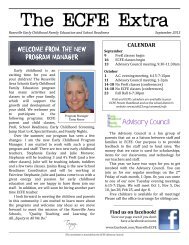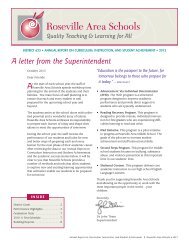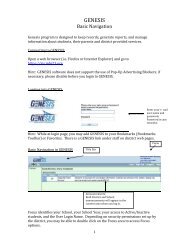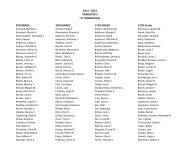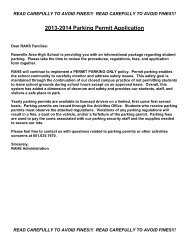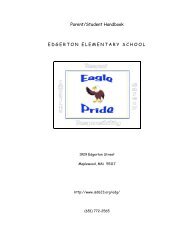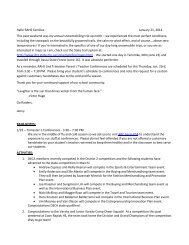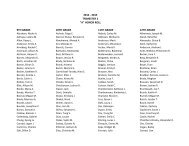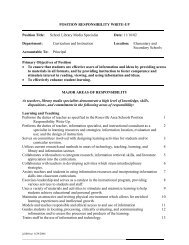Jane Prestebak (jane_prestebak@rdale.k12.mn.us) 8/16/2004 Draft
Jane Prestebak (jane_prestebak@rdale.k12.mn.us) 8/16/2004 Draft
Jane Prestebak (jane_prestebak@rdale.k12.mn.us) 8/16/2004 Draft
Create successful ePaper yourself
Turn your PDF publications into a flip-book with our unique Google optimized e-Paper software.
SCIENCE: Information Literacy Skills in the Minnesota Academic Standards<br />
Information literacy includes: research, technology skills, reading (for information and for pleasure) and media literacy, and<br />
responsible <strong>us</strong>e of information and information systems. MEMO’s recommended information and technology literacy standards<br />
are available at: http://www.memoweb.org.<br />
Science<br />
Strand Sub-strand Standard Gr<br />
ade<br />
s<br />
I.<br />
HISTORY<br />
AND<br />
NATURE<br />
OF<br />
SCIENCE<br />
I.<br />
HISTORY<br />
AND<br />
NATURE<br />
OF<br />
SCIENCE<br />
I.<br />
HISTORY<br />
AND<br />
NATURE<br />
OF<br />
SCIENCE<br />
B.<br />
Scientific<br />
Inquiry<br />
B.<br />
Scientific<br />
Inquiry<br />
A.<br />
Scientific<br />
World<br />
View<br />
The student will raise<br />
questions about the natural<br />
world<br />
The student will raise<br />
questions about the natural<br />
world, make careful<br />
observations, and seek<br />
answers.<br />
The student will understand<br />
that science is a human<br />
endeavor practiced<br />
throughout the world.<br />
k<br />
Benchmarks<br />
1. The student will observe and describe common objects<br />
<strong>us</strong>ing simple tools.<br />
1 1. The student will observe, describe, measure, compare and<br />
contrast common objects, <strong>us</strong>ing simple tools including but<br />
not limited to ruler, thermometer and balance.<br />
2 1. The student will recognize that repeating a scientific<br />
investigation will lead to very similar results.<br />
2. The student will recognize that scientific investigations<br />
generally work the same way in different places.<br />
3. The student will give examples of scientific advances<br />
throughout history.<br />
4. The student will recognize that everyone can do science<br />
and invent things and ideas.<br />
Info. Lit.<br />
Research<br />
process,<br />
Technology<br />
integration*<br />
Research<br />
process,<br />
Technology<br />
integration*<br />
Research<br />
process,<br />
Technology<br />
integration*<br />
I.<br />
HISTORY<br />
B.<br />
Scientific<br />
The student will raise<br />
questions about the natural<br />
2 1. The student will <strong>us</strong>e appropriate tools to gather and<br />
organize data.<br />
Research<br />
process,<br />
<strong>Jane</strong> <strong>Prestebak</strong> (<strong>jane</strong>_<strong>prestebak@rdale</strong>.<strong>k12.mn</strong>.<strong>us</strong>) 8/<strong>16</strong>/<strong>2004</strong> <strong>Draft</strong>
AND<br />
NATURE<br />
OF<br />
SCIENCE<br />
I.<br />
HISTOR<br />
Y AND<br />
NATURE<br />
OF<br />
SCIENCE<br />
Inquiry<br />
A.<br />
Scientific<br />
World<br />
View<br />
world, make careful<br />
observations, and seek<br />
answers.<br />
The student will understand<br />
the <strong>us</strong>e of science as a tool<br />
to examine the natural<br />
world.<br />
2. The student will recognize and describe patterns in data. Technology<br />
integration*<br />
3 1. The student will explore the <strong>us</strong>e of science as a tool<br />
that can help investigate and answer questions about the<br />
environment.<br />
Research<br />
process,<br />
Technology<br />
integration*<br />
I.<br />
HISTORY<br />
AND<br />
NATURE<br />
OF<br />
SCIENCE<br />
I.<br />
HISTOR<br />
Y AND<br />
NATURE<br />
OF<br />
SCIENCE<br />
I.<br />
HISTOR<br />
Y AND<br />
NATURE<br />
OF<br />
SCIENCE<br />
I.<br />
HISTOR<br />
B.<br />
Scientific<br />
Inquiry<br />
A.<br />
Scientific<br />
World<br />
View<br />
B.<br />
Scientific<br />
Inquiry<br />
A.<br />
Scientific<br />
The student will understand<br />
the nature of scientific<br />
investigations.<br />
The student will understand<br />
how science is <strong>us</strong>ed to<br />
Investigate interactions<br />
between people and the<br />
natural world.<br />
The student will participate<br />
in a controlled scientific<br />
investigation.<br />
The student will understand<br />
that communication is<br />
3 1. The student will ask questions about the natural world<br />
that can be investigated scientifically.<br />
2. The student will participate in a scientific investigation<br />
<strong>us</strong>ing appropriate tools.<br />
3. The student will know that scientists <strong>us</strong>e different<br />
kinds of investigations depending on the questions they<br />
are trying to answer.<br />
4 1. The student will explore the <strong>us</strong>es and effects of science<br />
in our interaction with the natural world.<br />
2. The student will disc<strong>us</strong>s the responsible <strong>us</strong>e of science.<br />
3. The student will recognize the impact of scientific and<br />
technological activities on the natural world.<br />
4 1. The student will recognize when comparisons might<br />
not be fair beca<strong>us</strong>e some conditions are not kept the same.<br />
2. The student will collect, organize, analyze and present<br />
data from a controlled experiment.<br />
3. The student will recognize that evidence and logic are<br />
necessary to support scientific understandings.<br />
5 1. The student will know that current scientific<br />
knowledge and understanding guide scientific<br />
Research<br />
process,<br />
Technology<br />
integration*<br />
Research<br />
process,<br />
Responsible<br />
<strong>us</strong>e<br />
Research<br />
process,<br />
Technology<br />
integration*<br />
Research<br />
process,<br />
<strong>Jane</strong> <strong>Prestebak</strong> (<strong>jane</strong>_<strong>prestebak@rdale</strong>.<strong>k12.mn</strong>.<strong>us</strong>) 8/<strong>16</strong>/<strong>2004</strong> <strong>Draft</strong>
Y AND<br />
NATURE<br />
OF<br />
SCIENCE<br />
I.<br />
HISTOR<br />
Y AND<br />
NATURE<br />
OF<br />
SCIENCE<br />
World<br />
View<br />
B.<br />
Scientific<br />
Inquiry<br />
essential to science.<br />
The student will understand<br />
the process of scientific<br />
investigations.<br />
investigation.<br />
2. The student will recognize that clear communication of<br />
methods, findings and critical review is an essential part<br />
of doing science.<br />
5 1. The student will perform a controlled experiment <strong>us</strong>ing<br />
a specific step-by-step procedure and present concl<strong>us</strong>ions<br />
supported by the evidence.<br />
2. The student will observe that when a science<br />
investigation or experiment is repeated, a similar result is<br />
expected.<br />
Responsible<br />
<strong>us</strong>e<br />
Research<br />
process,<br />
Technology<br />
integration*<br />
I.<br />
HISTOR<br />
Y AND<br />
NATURE<br />
OF<br />
SCIENCE<br />
C.<br />
Scientific<br />
Enterprise<br />
The student will recognize<br />
that science and technology<br />
involve different kinds of<br />
work and engages men and<br />
women of all backgrounds.<br />
5 1. The student will describe different kinds of work done<br />
in science and technology.<br />
2. The student will identify men and women of vario<strong>us</strong><br />
backgrounds and ages who have been involved in science<br />
and technology, both past<br />
and present.<br />
Reading for<br />
information<br />
I.<br />
HISTOR<br />
Y AND<br />
NATURE<br />
OF<br />
SCIENCE<br />
A.<br />
Scientific<br />
World<br />
View<br />
The student will understand<br />
that science is a way of<br />
knowing about the world<br />
that is characterized by<br />
empirical criteria, logical<br />
argument and skeptical<br />
review.<br />
6 1. The student will distinguish between scientific<br />
evidence and personal opinion.<br />
2. The student will explain why scientists often repeat<br />
investigations to be sure of the results.<br />
3. The student will recognize that scientists assume that<br />
the laws of nature are the same everywhere and that they<br />
are understandable and predictable.<br />
4. The student will define scientific facts, laws and<br />
theories.<br />
Research<br />
process<br />
I.<br />
HISTOR<br />
Y AND<br />
NATURE<br />
B.<br />
Scientific<br />
Inquiry<br />
The student will understand<br />
that scientific inquiry is <strong>us</strong>ed<br />
in systematic ways to<br />
investigate the natural<br />
6 1. The student will identify questions that can be<br />
answered through scientific investigation and those that<br />
cannot.<br />
2. The student will distinguish among observation,<br />
Research<br />
process,<br />
Technology<br />
integration*<br />
<strong>Jane</strong> <strong>Prestebak</strong> (<strong>jane</strong>_<strong>prestebak@rdale</strong>.<strong>k12.mn</strong>.<strong>us</strong>) 8/<strong>16</strong>/<strong>2004</strong> <strong>Draft</strong>
OF<br />
SCIENCE<br />
I.<br />
HISTOR<br />
Y AND<br />
NATURE<br />
OF<br />
SCIENCE<br />
C.<br />
Scientific<br />
Enterprise<br />
world.<br />
The student will know that<br />
science and technology are<br />
human efforts that both<br />
influence and are influenced<br />
by society.<br />
prediction and inference.<br />
3. The student will <strong>us</strong>e appropriate tools and Système<br />
International (SI) units for measuring length, time, mass,<br />
volume and temperature with suitable precision and<br />
accuracy.<br />
4. The student will present and explain data and findings<br />
from controlled experiments <strong>us</strong>ing multiple<br />
representations including tables, graphs, physical models<br />
and demonstrations.<br />
6 1. The student will describe the types of questions asked,<br />
the products, and the methods of investigation <strong>us</strong>ed to<br />
distinguish science from technology.<br />
2. The student will explain why scientists may work in<br />
teams or work alone, can collaborate and, at times,<br />
compete.<br />
Research<br />
process,<br />
Responsible<br />
<strong>us</strong>e<br />
I.<br />
HISTOR<br />
Y AND<br />
NATURE<br />
OF<br />
SCIENCE<br />
A.<br />
Scientific<br />
World<br />
View<br />
The student will understand<br />
that science is a way of<br />
knowing about the world<br />
that is characterized by<br />
empirical criteria, logical<br />
argument and skeptical<br />
review.<br />
7 1. The student will recognize how scientific knowledge is<br />
subject to change as new evidence becomes available, or<br />
as new theories ca<strong>us</strong>e scientists to look at old<br />
observations differently.<br />
2. The student will explain natural phenomena by <strong>us</strong>ing<br />
appropriate physical, conceptual and mathematical<br />
models.<br />
Research<br />
process,<br />
Technology<br />
integration*<br />
I.<br />
HISTOR<br />
Y AND<br />
NATURE<br />
OF<br />
SCIENCE<br />
B.<br />
Scientific<br />
Inquiry<br />
The student will design and<br />
conduct scientific<br />
investigations.<br />
7 1. The student will formulate a testable hypothesis based<br />
on prior knowledge.<br />
2. The student will recognize that a variable is a condition<br />
that may influence the outcome of an investigation and<br />
know the importance of manipulating one variable at a<br />
time.<br />
3. The student will write a specific step-by-step procedure<br />
for a scientific investigation.<br />
Research<br />
process,<br />
Technology<br />
integration*<br />
<strong>Jane</strong> <strong>Prestebak</strong> (<strong>jane</strong>_<strong>prestebak@rdale</strong>.<strong>k12.mn</strong>.<strong>us</strong>) 8/<strong>16</strong>/<strong>2004</strong> <strong>Draft</strong>
I.<br />
HISTOR<br />
Y AND<br />
NATURE<br />
OF<br />
SCIENCE<br />
I.<br />
HISTOR<br />
Y AND<br />
NATURE<br />
OF<br />
SCIENCE<br />
I.<br />
HISTOR<br />
Y AND<br />
NATURE<br />
OF<br />
SCIENCE<br />
I.<br />
HISTOR<br />
Y AND<br />
NATURE<br />
OF<br />
SCIENCE<br />
I.<br />
HISTOR<br />
C.<br />
Scientific<br />
Enterprise<br />
A.<br />
Scientific<br />
World<br />
View<br />
B.<br />
Scientific<br />
Inquiry<br />
B.<br />
Scientific<br />
Inquiry<br />
C.<br />
Scientific<br />
The student will know that<br />
science and technology are<br />
human efforts that both<br />
influence, and are<br />
influenced by, society.<br />
The student will understand<br />
that science is a way of<br />
knowing about the world<br />
that is characterized by<br />
empirical criteria, logical<br />
argument and skeptical<br />
review.<br />
The student will understand<br />
that scientific inquiry is<br />
<strong>us</strong>ed by scientists to<br />
investigate the natural world<br />
in systematic ways.<br />
The student will <strong>us</strong>e<br />
multiple skills to design and<br />
conduct scientific<br />
investigations.<br />
The student will know that<br />
science and technology are<br />
4. The student will explain how classroom scientific<br />
investigations relate to established scientific principles.<br />
7 1. The student will give examples of the development of<br />
technology influencing scientific knowledge, and<br />
investigation and scientific knowledge influencing the<br />
development of technology.<br />
8 1. The student will explain and give examples of how<br />
science can be <strong>us</strong>ed to make informed ethical decisions<br />
by identifying likely consequences of particular actions.<br />
2. The student will explain the development, <strong>us</strong>efulness<br />
and limitations of scientific models in the explanation and<br />
prediction of natural phenomena.<br />
8 1. The student will know that scientific investigations<br />
involve the common elements of systematic observations,<br />
the careful collection of relevant evidence, logical<br />
reasoning and innovation in developing hypotheses and<br />
explanations.<br />
2. The student will describe how scientists can conduct<br />
investigations in a simple system and make<br />
generalizations to more complex systems.<br />
8 1. The student will specify variables to be changed,<br />
controlled and measured.<br />
2. The student will <strong>us</strong>e sufficient trials and adequate<br />
sample size to ensure reliable data.<br />
3. The student will <strong>us</strong>e appropriate technology and<br />
mathematics skills to access, gather, store, retrieve and<br />
organize data.<br />
8 1. The student will evaluate the credibility and validity of<br />
scientific and technological information from vario<strong>us</strong><br />
Research<br />
process,<br />
Reading for<br />
information<br />
Research<br />
process,<br />
Responsible<br />
<strong>us</strong>e<br />
Research<br />
process<br />
Research<br />
process,<br />
Technology<br />
Skills<br />
Research<br />
process<br />
<strong>Jane</strong> <strong>Prestebak</strong> (<strong>jane</strong>_<strong>prestebak@rdale</strong>.<strong>k12.mn</strong>.<strong>us</strong>) 8/<strong>16</strong>/<strong>2004</strong> <strong>Draft</strong>
Y AND<br />
NATURE<br />
OF<br />
SCIENCE<br />
Enterprise<br />
human efforts that both<br />
influence and are influenced<br />
by civilizations and cultures<br />
worldwide.<br />
sources.<br />
I.<br />
HISTOR<br />
Y AND<br />
NATURE<br />
OF<br />
SCIENCE<br />
D. Historic<br />
Perspectiv<br />
es<br />
The student will understand<br />
how scientific discovery,<br />
culture, societal norms and<br />
technology have influenced<br />
one another in different<br />
time periods.<br />
8 1. The student will relate personal experiences in<br />
scientific investigation to the experiences of scientists<br />
throughout history.<br />
2. The student will cite examples of how science and<br />
technology contributed to changes in agriculture,<br />
manufacturing, sanitation, medicine, warfare,<br />
transportation, information<br />
Research<br />
process,<br />
Reading for<br />
information<br />
I.<br />
HISTOR<br />
Y AND<br />
NATURE<br />
OF<br />
SCIENCE<br />
A.<br />
Scientific<br />
World<br />
View<br />
The student will understand<br />
the nature of scientific ways<br />
of thinking and that<br />
scientific knowledge<br />
changes and accumulates<br />
over time.<br />
9-<br />
12<br />
1. The student will be able to distinguish among<br />
hypothesis, theory and law as scientific terms and how<br />
they are <strong>us</strong>ed to answer a specific question.<br />
2. The student will be able to explain how scientific and<br />
technological innovations as well as new evidence can<br />
challenge portions of or entire<br />
accepted theories and models including but not limited to<br />
cell theory, atomic theory, theory of evolution, plate<br />
tectonic theory, germ theory of disease and big bang<br />
theory.<br />
3. The student will recognize that in order to be valid,<br />
scientific knowledge m<strong>us</strong>t meet certain criteria including<br />
that it: be consistent with experimental, observational and<br />
inferential evidence about nature; follow rules of logic<br />
and reporting both methods and procedures; and, be<br />
falsifiable and open to criticism.<br />
4. The student will explain how traditions of ethics, peer<br />
review, conflict and general consens<strong>us</strong> influences the<br />
conduct of science.<br />
Research<br />
process<br />
<strong>Jane</strong> <strong>Prestebak</strong> (<strong>jane</strong>_<strong>prestebak@rdale</strong>.<strong>k12.mn</strong>.<strong>us</strong>) 8/<strong>16</strong>/<strong>2004</strong> <strong>Draft</strong>
I.<br />
HISTOR<br />
Y AND<br />
NATURE<br />
OF<br />
SCIENCE<br />
I.<br />
HISTOR<br />
Y AND<br />
NATURE<br />
OF<br />
SCIENCE<br />
B.<br />
Scientific<br />
Inquiry<br />
C.<br />
Scientific<br />
Enterprise<br />
The student will design and<br />
conduct a scientific<br />
investigation.<br />
The student will understand<br />
the relationship between<br />
science and technology and<br />
how both are <strong>us</strong>ed.<br />
9-<br />
12<br />
9-<br />
12<br />
5. The student will recognize that some scientific ideas<br />
are incomplete, and opportunity exists in these areas for<br />
new advances.<br />
1. The student will design and complete a scientific<br />
experiment <strong>us</strong>ing scientific methods by determining a<br />
testable question, making a hypothesis, designing a<br />
scientific investigation with appropriate controls,<br />
analyzing data, making concl<strong>us</strong>ions based on evidence<br />
and comparing concl<strong>us</strong>ions to the original hypothesis and<br />
prior knowledge.<br />
2. The student will distinguish between qualitative and<br />
quantitative data.<br />
3. The student will apply mathematics and models to<br />
analyze data and support concl<strong>us</strong>ions.<br />
4. The student will identify possible sources of error and<br />
their effects on results.<br />
5. The student will know that professional scientists and<br />
engineers have ethical codes.<br />
6. The student will give examples of how different<br />
domains of science <strong>us</strong>e different bodies of scientific<br />
knowledge and employ different methods to investigate<br />
questions.<br />
1. The student will compare and contrast the purposes and<br />
career opportunities of engineering, technology and<br />
science.<br />
2. The student will provide an example of a need or<br />
problem identified by science and solved by engineering<br />
or technology.<br />
3. The student will provide an example of how<br />
technology facilitates new discoveries and the<br />
development of scientific knowledge.<br />
4. The student will know that technological changes and<br />
Research<br />
process,<br />
Technology<br />
integration*<br />
Research<br />
process<br />
<strong>Jane</strong> <strong>Prestebak</strong> (<strong>jane</strong>_<strong>prestebak@rdale</strong>.<strong>k12.mn</strong>.<strong>us</strong>) 8/<strong>16</strong>/<strong>2004</strong> <strong>Draft</strong>
I.<br />
HISTOR<br />
Y AND<br />
NATURE<br />
OF<br />
SCIENCE<br />
D. Historic<br />
Perspectives<br />
The student will recognize<br />
the historical and cultural<br />
context of scientific<br />
endeavors and how they<br />
influence each other.<br />
9-<br />
12<br />
scientific advances are often accompanied by social,<br />
political, environmental and economic changes.<br />
5. The student will recognize that science and technology<br />
are influenced by cultural backgrounds and beliefs and by<br />
social needs, attitudes, values and limitations.<br />
1. The student will be able to trace the development of a<br />
scientific advancement, invention or theory and its impact<br />
on society.<br />
2. The student will provide examples of scientific<br />
advancements contributed by other civilizations and<br />
cultures.<br />
3. The student will compare and contrast the differences<br />
between scientific theories and theories from other bodies<br />
of knowledge, and the importance of each in a science<br />
disc<strong>us</strong>sion.<br />
Research<br />
process,<br />
Reading for<br />
information,<br />
Technology<br />
integration*<br />
*Use of information technology tools is not stated in the standards, but could be integrated.<br />
<strong>Jane</strong> <strong>Prestebak</strong> (<strong>jane</strong>_<strong>prestebak@rdale</strong>.<strong>k12.mn</strong>.<strong>us</strong>) 8/<strong>16</strong>/<strong>2004</strong> <strong>Draft</strong>



